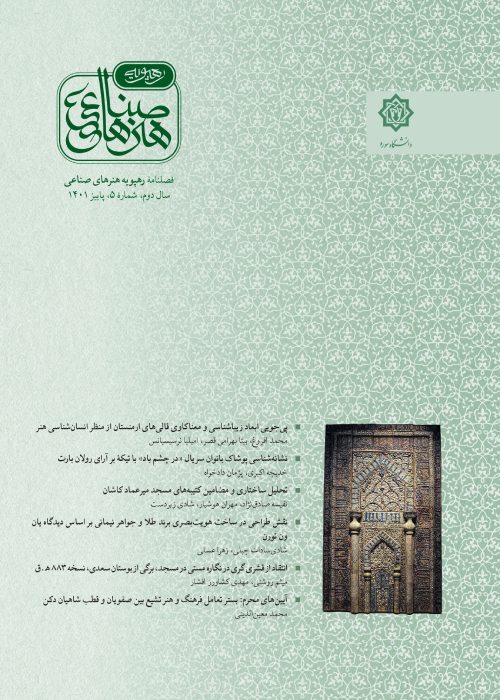Muharram Ceremony: The Platform for the Interaction of Shiite Culture Between the Safavid and the Qutb Shahi
Author(s):
Article Type:
Research/Original Article (بدون رتبه معتبر)
Abstract:
The aim of this study is to understand how Iranian Shiite culture influences Qutb shahis Shiite religious ceremonies, especially Muharram mourning ceremonies in Deccan, and how Iranian cultural patterns were combined with the local traditions of this region. With the spread of Islam in Asia, large parts of the Indian subcontinent were influenced by Islam various religions. Specefic India's cultural characteristics have made the land one of the most important centers of Muslim immigrants for centuries. Some of these immigrants were Iranian Shi‘i who gradually gained their social base in different parts of India, especially Deccan. with the choice of Shi‘i as the official religion of some Deccan dynasties, especially the Qutb Shahis, the social and cultural base of the Iranian Shiites in this land became stronger and subsequently a new form of Hindu-Iranian culture was formed in this region.Qutb Shahi's trust in the Iranian agents, along with the religious tolerance of the sultans of this dynasty, as well as their immigration and economic policies, had caused a large number of Iranians to migrate to Deccan. The widespread Iranian influence at that time caused the Shiite ceremony to be influenced by the Iranian culture in three areas, " ashurkhana" as the place of holding the ceremony", "the method of holding the ceremony" and "Alam" as one of the symbolic objects of this ceremony. But this influence depended on a kind of cultural power that changed with the decline of the power of the Qutb shahis, the weakening role of the Iranian elite in their court, and the decline of the population of Iranian immigrants. As a result, despite the fact that in the beginning there was a deep connection between the cultural patterns of Iran and this region, but gradually many of the components of holding these rituals were linked to the indigenous traditions of India to find unique features of their region.The aim of this study is to understand how Iranian Shiite culture influences Qutb shahis Shiite religious ceremonies, especially Muharram mourning ceremonies in Deccan, and how Iranian cultural patterns were combined with the local traditions of this region. With the spread of Islam in Asia, large parts of the Indian subcontinent were influenced by Islam various religions. Specefic India's cultural characteristics have made the land one of the most important centers of Muslim immigrants for centuries. Some of these immigrants were Iranian Shi‘i who gradually gained their social base in different parts of India, especially Deccan. with the choice of Shi‘i as the official religion of some Deccan dynasties, especially the Qutb Shahis, the social and cultural base of the Iranian Shiites in this land became stronger and subsequently a new form of Hindu-Iranian culture was formed in this region.Qutb Shahi's trust in the Iranian agents, along with the religious tolerance of the sultans of this dynasty, as well as their immigration and economic policies, had caused a large number of Iranians to migrate to Deccan. The widespread Iranian influence at that time caused the Shiite ceremony to be influenced by the Iranian culture in three areas, " ashurkhana" as the place of holding the ceremony", "the method of holding the ceremony" and "Alam" as one of the symbolic objects of this ceremony. But this influence depended on a kind of cultural power that changed with the decline of the power of the Qutb shahis, the weakening role of the Iranian elite in their court, and the decline of the population of Iranian immigrants.
Keywords:
Language:
Persian
Published:
Journal of Industrial Arts, Volume:2 Issue: 3, 2022
Pages:
79 to 93
magiran.com/p2672579
دانلود و مطالعه متن این مقاله با یکی از روشهای زیر امکان پذیر است:
اشتراک شخصی
با عضویت و پرداخت آنلاین حق اشتراک یکساله به مبلغ 1,390,000ريال میتوانید 70 عنوان مطلب دانلود کنید!
اشتراک سازمانی
به کتابخانه دانشگاه یا محل کار خود پیشنهاد کنید تا اشتراک سازمانی این پایگاه را برای دسترسی نامحدود همه کاربران به متن مطالب تهیه نمایند!
توجه!
- حق عضویت دریافتی صرف حمایت از نشریات عضو و نگهداری، تکمیل و توسعه مگیران میشود.
- پرداخت حق اشتراک و دانلود مقالات اجازه بازنشر آن در سایر رسانههای چاپی و دیجیتال را به کاربر نمیدهد.
In order to view content subscription is required
Personal subscription
Subscribe magiran.com for 70 € euros via PayPal and download 70 articles during a year.
Organization subscription
Please contact us to subscribe your university or library for unlimited access!


